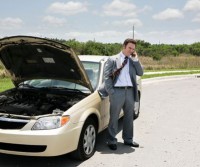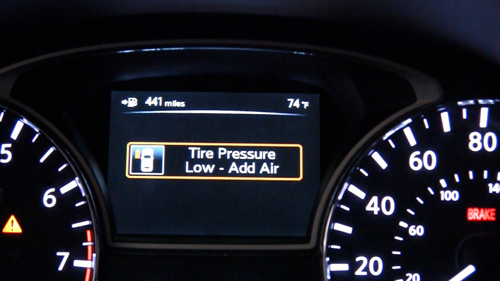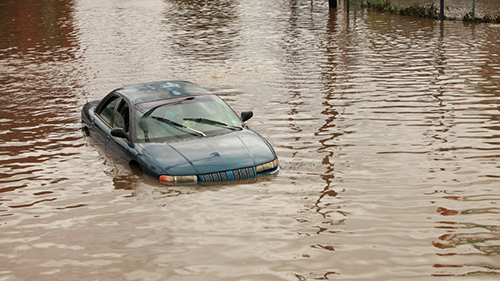While it may seem like a mundane task, inflating tires is much more crucial to your car than you may think, and it results in a safer and more economical experience on the road. Your vehicle’s handling also will be greatly improved as the larger a tire’s inflated footprint, the more responsive and comfier the ride balance will be.
Because it’s National Tire Safety Week, it’s the perfect time to check your car’s tires.
Before starting
To find your tires’ proper inflation level, look for a sticker on the driver-side doorjamb. It displays the vehicle weight restriction and tire information. The info is also found in the maintenance or car-care section of your vehicle’s owner’s manual.
Don’t refer to the sidewall markings on your tires, which in part specify the maximum tire pressure — not the recommended pressure.
Unless your tire is visibly flat, don’t judge tire inflation just by looking at it; you have to use a tire pressure gauge to get the correct pounds per square inch reading. There are three types of tire-pressure gauges: digital, internal slide and dial. Prices range from $5 for a basic gauge to more than $30 for one that is digital, has an air-release button — or even talks. All will do the job, but you may want to consider the conditions in which you’ll be using your gauge. “We’ve found that low-cost digital pressure gauges are very accurate and maintain the accuracy longer, but in extremely cold temperatures the gauge may not show up properly,” said John Rastetter, Tire Rack’s director of tire information services.
Tips for checking and filling your tires
Tire manufacturers suggest checking tires when they’re cold for the most accurate reading. Outside temperatures can cause tire pressure to vary by as much as 1 psi per 10 degrees; higher temperatures mean higher psi readings. “Tires are black; what does black do? Attract heat,” Rastetter said, noting the importance of finding a shady place to check and fill all four tires.
Temperature plays a huge part in tire psi, Rastetter said, adding that the most crucial time of year to check pressure is in fall and winter when days are shorter and average temperatures plummet.
Check your tires in the morning before going anywhere, because as soon as you get behind the wheel for an extended amount of time, psi will rise. Rastetter said that if you’ve been on the road a long time and notice higher psi in your tires, don’t let the air out, as the increase in pressure has built up due to the warm, constantly-in-motion tires
What to do
1. Pull your car onto a level surface in the shade.
2. Remove dust caps from the tires’ valve stems.
3. Using your tire gauge, firmly press the tip of the gauge straight on to the tire’s valve stem for a brief moment.
4. The tire gauge should provide a psi reading; if the number seems unrealistically low or high — for example, 85 psi or 1 psi – you will need to repeat the previous step, ensuring that the tire gauge’s tip is properly making contact with the valve stem.
5. If the tire gauge’s recorded reading is higher than the manufacturer-recommended rating, press the gauge tip on the valve stem until you hear air leak out. Check the tire pressure again.
6. If the reading is lower than recommended, fill the tire with air by firmly pressing the air-hose tip onto the valve stem. You will hear air quietly enter the tire. If you hear air leaking or spraying out, you need to double-check that the connection between the air hose and the tire’s valve stem is secure.
7. When you think you’ve added or let out enough air, check the pressure a few times with the gauge.
8. Replace the valve dust caps. Rastetter emphasized the importance of keeping dust caps on during winter driving because if water gets into the valve stem and freezes inside the tire, it could cause a flat.
While you’re at it, check your spare tire’s pressure. You don’t want to have a flat tire and then find out your replacement is flat, too.
Make these steps part of your routine. It will benefit your vehicle and your wallet.
Source: Cars.com
Detroit was pummeled with torrents of record-breaking rain Monday evening, stranding drivers on flooded freeways and leaving one dead.
The city received 4.57 inches of rain Monday, Detroit’s second highest on record following a rainfall of 4.74 inches in 1925, according to the National Weather Service. Some communities received more than 6 inches of rain. In contrast, the average rainfall for all of August is just 3 inches.
Rain fell throughout the day, but during afternoon commuting hours it filled local freeways. Water reached heights of 14 feet on certain roadways, according to the Detroit News, forcing some drivers to abandon their cars and prompting the Michigan State Police to send divers to look at the freeways.
Flash flooding has also resulted in that familiar and unfortunate sight of swamped cars. Remember: Never try to cross or drive on a flooded roadway. Even a couple feet of water is enough to sweep away your vehicle — and you with it. But if you do find yourself trapped in a flooded vehicle, MetrotechCollision.com reiterates the following important safety tips:
Do
- Stay calm. You’ll need your wits about you.
- Turn on your headlights and hazard lights. This will make it easier for emergency personnel to see you.
- Unbuckle your seat belt.
- Unlock your doors.
- Take jackets and outer clothing off.
- Lower your window. Most electric windows should work unless the car is completely submerged in water.
- If you can lower the windows, do so, but slowly. Climb out. Get to high ground and call 911.
- If the windows will not open, you’ll have to use a door to get out. But you won’t be able to open a door until the water pressure is equalized between the outside and the inside of the car. This means you’ll have to wait for water to enter the car and fill up to about your neck level (this sounds terrifying, but this is the only way the doors will open).
- Once the doors are open, tread water and swim to safety; call 911.
Don’t
- Do not panic.
- Do not use your energy trying to open the doors because water pressure will keep them from budging (wait for the pressure to equalize).
- Do not try to save your possessions.
- Do not try to break windows to get out. If water pressure has not equalized, glass will explode inward toward you or other occupants.
- Once out, do not stay with your car. Get to high ground.
- Do not stand on the roof of your car. If your car is swept away, you’ll be carried away with it. You could also fall and injure yourself if the car shifts abruptly.
- Do not return to your car if you think the water level is going down. Water levels could rise without warning. Allow emergency personnel to tow your vehicle to a safe place.
Are you hoping that your car lasts forever? While this may not be possible, there are steps you can take to prolong its life. By doing so, you will find yourself saving a lot of money along the way.
Here are five tips to make your car last longer:
1. Change your car’s oil and filter on a regular basis. This is discussed time and time again, however, some continually overlook the importance. Read your owner’s manual for more information on how often you should do this, and then stick to the schedule no matter what.
2. Keep an eye on your tires. Did you know that over or under-inflated tires can have an impact on many parts of your car? On top of this, it can impact the actual tires as well as your gas mileage.
3. Visit a mechanic on a regular basis. Just because you don’t see something on the surface doesn’t mean there is nothing wrong with your car. A well qualified mechanic can pinpoint potential problems before they turn into serious and costly repairs.
4. Be observant. When was the last time you gave your car a good “once over?” You don’t have to spend hours on end inspecting your car, but it never hurts to take a few minutes to walk around your car and see if anything sticks outs.
5. Keep your car clean. Believe it or not, regularly washing and waxing your vehicle will increase its lifespan. No matter if you do it yourself or drive through a carwash, you are getting the same benefit.
By following these five tips, you will find it much easier to extend the life of your vehicle. And that is what you want, right?
Most people understand that regular car maintenance is critical to ensuring the safety and reliability of their vehicle. But did you know that this can also save you money? From following regular service intervals to visiting your mechanic when something fishy is going on, the more proactive you are the better chance you have of saving money down the road.
Here are five ways regular maintenance can save you money:
1. Fix small, inexpensive problems before they grow into something bigger. A $100 repair today could save you from spending thousands tomorrow. Is this a tradeoff you are willing to make?
2. Uncover other problems. During a regular inspection, your mechanic may find a problem that you were unaware of. By doing so, this issue can be taken care of immediately, ensuring that you don’t face a bigger problem later on (see #1 above).
3. Save money on towing. The last thing you want is to be stranded on the side of the road, forced to call a tow truck for assistance. With the proper maintenance schedule, there is less of a chance that your vehicle will need towed.
4. Save money on labor. Did you know that regular maintenance typically requires less time than an advanced repair? You are going to be charged by the hour in most cases, so you want to avoid advanced repairs if at all possible.
5. Tips from your mechanic. At Metrotech, we do our best to provide clients with information and advice on how to keep their vehicle in good condition. With a regular maintenance schedule, you will always have time to consult with a qualified professional. Subsequently, you can implement this advice to avoid future problems.
Now do you see why regular car maintenance is so important? Not only can this save you money, but it can help you avoid a lot of stress.

Every day, people from one side of the country to the next take to the roadways. Some do so for work and others for pleasure. Regardless of why you are hitting the road, there is always the chance that your car will breakdown.
While you can protect against this with the proper maintenance schedule, even then there is no way of guaranteeing that a breakdown will never occur.
Here are five things to do if you find yourself in this position:
1. Remove your car from traffic, if at all possible. Even if something goes terribly wrong with your vehicle, you should still be able to drive it to the shoulder of the road.
Note: If this is not possible, do not get out of your vehicle until you are 100 percent sure you can do so in a safe manner.
2. Call for help. Regardless of your situation, it is best to call for help as soon as it is safe to do so. From the police to a tow truck driver, decide who to call and then start dialing.
3. Alert others that you are in trouble. The use of hazard lights is a good start, but you may want to take things one step further by placing road flares 25 to 50 feet behind your vehicle (only if it is safe to do so).
4. Opt against a do-it-yourself repair. As tempting as it may be to pop the hood and take a closer look, this is not always the ideal time to do so. Your safety comes first, and attempting to make a repair on a crowded road is anything but safe.
5. Be patient. As frustrated as you may be, you need to exercise patience if your car breaks down. This will ensure your safety, while also giving you time to think through your situation.
Nobody wants to be in this situation, but if you find your car broken down the five tips above can be of great assistance.





